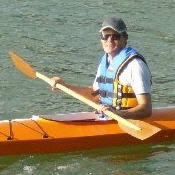
Not so amazing in itself, but there are a couple of things I was trying to prove. Firstly, I wanted the hull form and rig to closely mimic the White Heron, a Kiribati sailing canoe that is on display a the New Zealand National Maritime Museum in Auckland. Secondly, I wanted the design to be a modern translation, in plywood, with very simple shapes to minimize the need for complex lofting and also to use the fewest possible number of sheets.
I have a CAD drawing of the panels required to make the waka or main hull. It is possible to fit them all on 3 standard 1200x2400mm sheets of plywood, and I think 6mm ply would be sufficient for the job. The outrigger (ama) could be fashioned from a 100mm square fence post, 2400mm long by sawing crude point and then refining the shape with a coarse sanding wheel on an angle grinder. The spars could be akas (beams holding the ama) could be bamboo and the same possibly for the mast, but the spars I'm not sure on at the moment. To scale they are 4.5m long, sop probably scarfed and laminated softwood is looking the most likley. Softwood stock would also be required for gunwales, gluing battens and the mast and spar steps. The sail would be poly tarp.
Now the only problem is, I can't attach the PDF file I created from the CAD drawing, its a limitation of blogspot that I can't post attachments that aren't photo or video file types. This means I'll have to add more dimensional information before publishing them as jpegs, to allow others to lay out the panels. The great thing is, the shapes are so simple that I could almost manage a written description of each piece instead.
I'm not sure I'll ever build the real thing though. I've gone through the shunting process in miniature and its easy to imagine a disaster trying it for real at sea. I think the next step will be to develop a smaller version of the hull, 4 metres length at most, and equip it with a tipping Gibbon's rig.


No comments:
Post a Comment